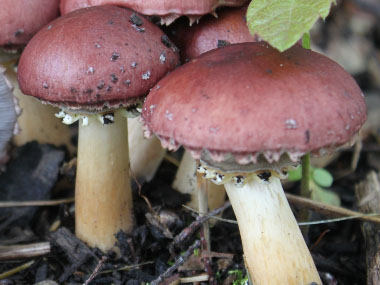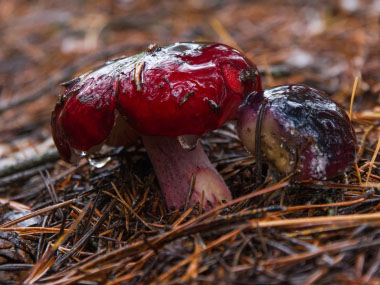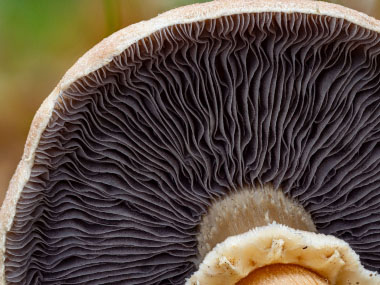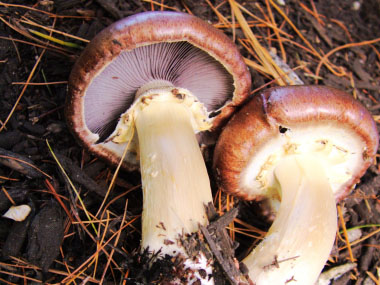





Do not eat any fungi that has not been properly identified by a qualified professional, some are DEADLY when ingested. All edible wild fungi MUST be cooked.
Wine cap mushrooms are medium to large umbrella-shaped agaric. Like most of its relatives, it has a circular pileus and a central stem. Unlike many agaric mushrooms, this does not have a volva. (Those with a volva are poisonous!) Its name, Rugos, means "wrinkle" or "fold" and annul, means "ring" (annulus). Rugosoannulata describes the wrinkled ring of this mushroom. It is easily recognized by its preference for woodchips and other urban habitats, and its purple-gray gills and spore print. This popular mushroom has many common names, some include, Wine Cap Stropharia, Burgundy Cap Mushroom, Garden Giant, and King Stropharia.
Type
Distinguishing Features
The wine red to reddish brown color of these mushrooms makes them easy to spot. The cap measures 4 to 13 cm (1.5 to 5”) across. It is convex at first then it becomes broadly convex to almost flat. When they first appear, they are sticky, but become glossy and dry. As they mature, they fade to yellowish brown or yellowish, sometimes developing cracks in old age. Sometimes veil remnants can be seen on the margins. The stalk can be from 8 to 16 cm long (4 to 7”) and 1 to 2 cm (.39 to .78”) thick. The stalk is white, generally cylindrical, some may have an enlarged base (but not a volva). The ring on the stalk is grooved or ridged on the upper surface, forming a unique “cogwheel” shape. White threads often emanating from base of stalk.
Height
This mushroom typically varies in height from 8 to 16 cm (4 to 7”) tall.
Habitat
Wine caps are saprobic. They grow scattered or gregariously, usually found on woodchips, in gardens, and in other cultivated areas. Sometimes they can be found along stream beds where spring floods have occurred.
Spore Print
Dark purple-brown to purplish black.
Season
Wine caps fruit in the spring through fall in temperate climates or when temperatures range from 10 to 21 degrees C (50 to 70 degrees F). The native range of wine caps spans across North America; however, they are significantly more widespread east of the Great Plains.
Gills
Attached to the stem; close or nearly crowded; short-gills frequent; whitish to pale gray at first, becoming purplish gray to purple-black.
Edibility
This is considered a choice mushroom. In fact, this is a sought-after mushroom to cultivate. Always gather these when they are wine red to reddish brown (burgundy) color.
Other Name
King Stropharia.
Recipes
To support our efforts please browse our store (books with medicinal info, etc.).
Winter Survival Food Handbook

PDF Plant Magazines
Types of Wild Food
Geographic Zones Seasons
Disclaimer
EdibleWildFood.com is informational in nature. While we strive to be 100% accurate, it is solely up to the reader to ensure proper plant identification. Some wild plants are poisonous or can have serious adverse health effects.
We are not health professionals, medical doctors, nor are we nutritionists. It is up to the reader to verify nutritional information and health benefits with qualified professionals for all edible plants listed in this web site. Please click here for more information.
Why Edible Wild Food?
- Food costs are rising
- Free, wild food is readily abundant
- Wild food adds nutrition to your diet
- Wild food can help treat various medical conditions





